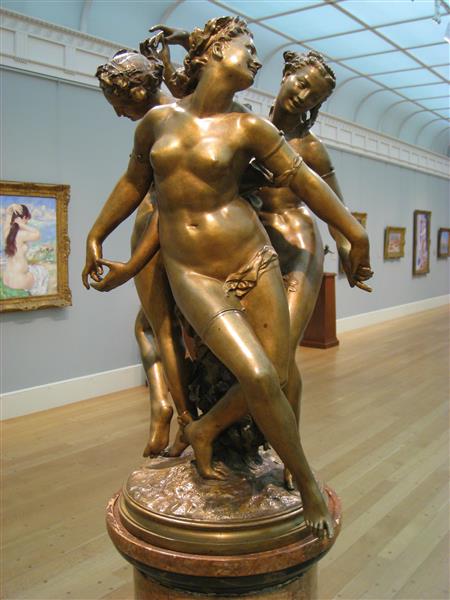
In art palaces around the world, the bronze statues of the three goddesses are a highly respected form of art, showcasing symbols of elegance, harmony, and beauty. These sculpture works, with their exquisite craftsmanship and profound symbolic significance, attract the attention of viewers and trigger endless imagination and thinking. This article will introduce 4 famousThree Graces Statue, exploring their history, artistic style, and symbolic significance.
Jean-Baptiste Carpeaux’s The Three Graces
Jean-Baptiste Carpeaux’s The Three Graces is a derivative of his renowned sculpture “Dance,” originally crafted for the façade of the Paris Opera House. This dynamic composition exemplifies Carpeaux’s signature style, portraying three Bacchantes (one adorned with ivy, another with roses, and the third with laurel) gracefully dancing in a circle around the Genius of Dance. Upon its debut in 1869, “Dance” sparked controversy for its perceived immorality. In a notable incident on August 27, 1869, an individual hurled a bottle of ink at the sculpture, staining one of the dancers. Nevertheless, today, this masterpiece is celebrated as one of Carpeaux’s most exquisite creations and is housed in the Musée d’Orsay in Paris (catalogued as RF 2884).

Antonio Canova’s Three Graces Statue
Three Graces Statue is Antonio Canova’s statue. It is a Neoclassical sculpture, in marble, of the mythological three Charites, daughters of Zeus – identified on some engravings of the statue as, from left to right, Euphrosyne, Aglaea and Thalia – who were said to represent youth/beauty (Thalia), mirth (Euphrosyne), and elegance (Aglaea). The Graces presided over banquets and gatherings, to delight the guests of the gods. They initially wore long white dresses like the other goddesses, but in later artistic representations they were usually nude.
The Three Graces represents beauty, joy and grace. That’s exactly what we want. Everyone wants to be beautiful, joyful and graceful. We put these beautiful allegories on the sculpture, hoping to give us encouragement and add beauty to our life through sculpture. It is a good decoration whether you put it indoors or outdoors. If you like the marble material, we also have the marble statue of the Three Graces. Good arts need to be brought home earlier.

Aristide Maillol‘ Les Trois Graces
The sculpture of the three goddesses by Aristide Maillol is one of his masterpieces, located in the Durelli Gardens in the first arrondissement of Paris, in an area called the Carousel Gardens. This statue is known as the “Les Trois Graces” (Three Elegances) and was originally created by Merlot in plaster from 1931 to 1937. It was later cast in lead material in 1938.
Although it is referred to as the “Three Goddesses,” Merol said that these female images are actually three fairies on the ground. He believed that these images were too powerful to fully represent traditional goddess images, so he chose to use lead material instead of bronze because he believed bronze was too dull. Therefore, these statues showcase a light and elegant beauty, complementing the natural environment surrounded by flowers and plants.

Three Goddesses of Fate
This is one of the famous sculptural masterpieces of the Southern European classical period, formerly known as the “Three Goddesses of Fate”. Originally a high relief at the end of the right corner on the front wall of the Parthenon Temple, the theme comes from Greek mythology. The existing statues of these three goddesses have lost their heads and limbs, but their robust bodies, peaceful and graceful postures, still give people an extremely beautiful image. Especially in the handling of the clothing of the three goddesses, Greek style thin shirts are worn on their bodies. The slender and complex wet pleats undulate with the structure of the human body, vividly showcasing the beautiful contours of the female body.

These four famous the 3 graces statue showcase the different interpretations of beauty, harmony, and elegance by artists from different periods and regions, bringing us profound reflections and insights on art and life. These sculpture works all showcase humanity’s relentless pursuit of beauty and longing for a harmonious life. May these elegant works of art forever illuminate our hearts and bring us a source of beauty and joy.











